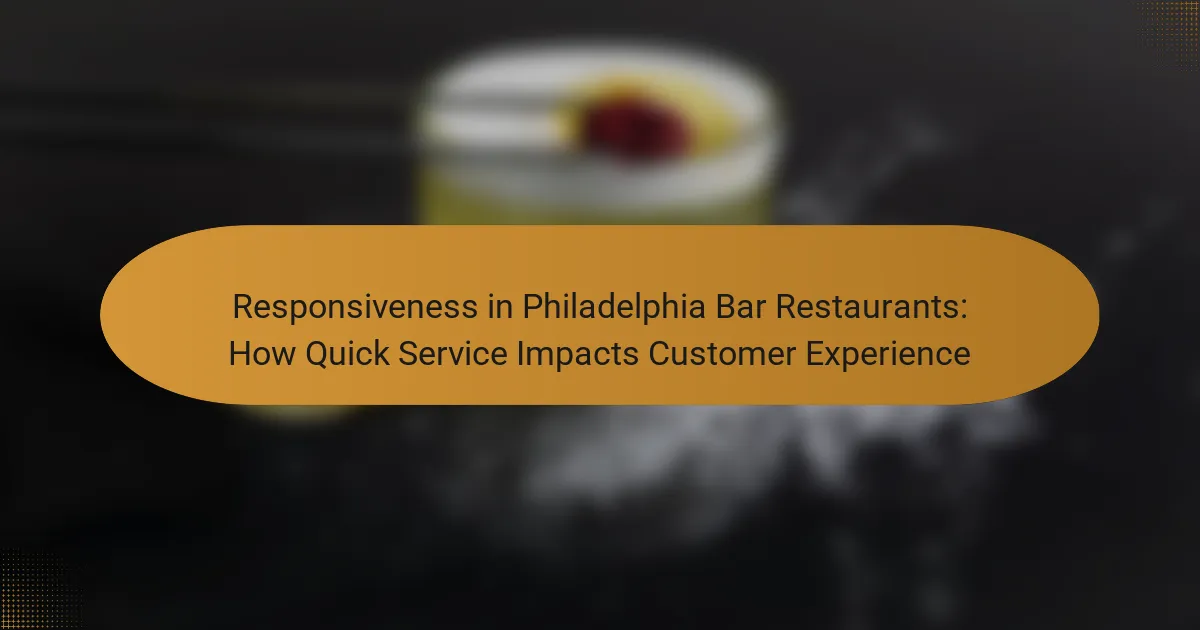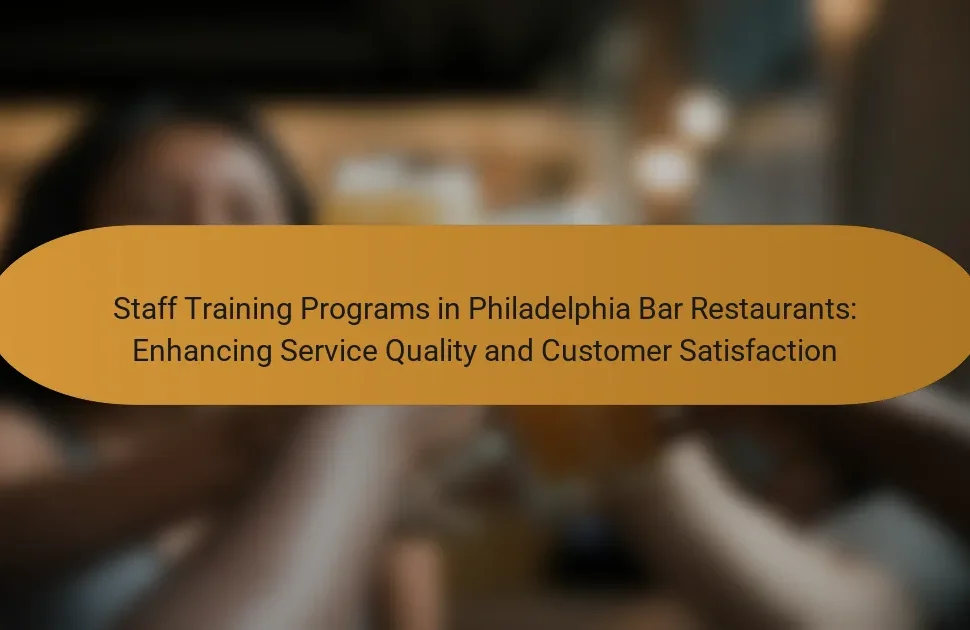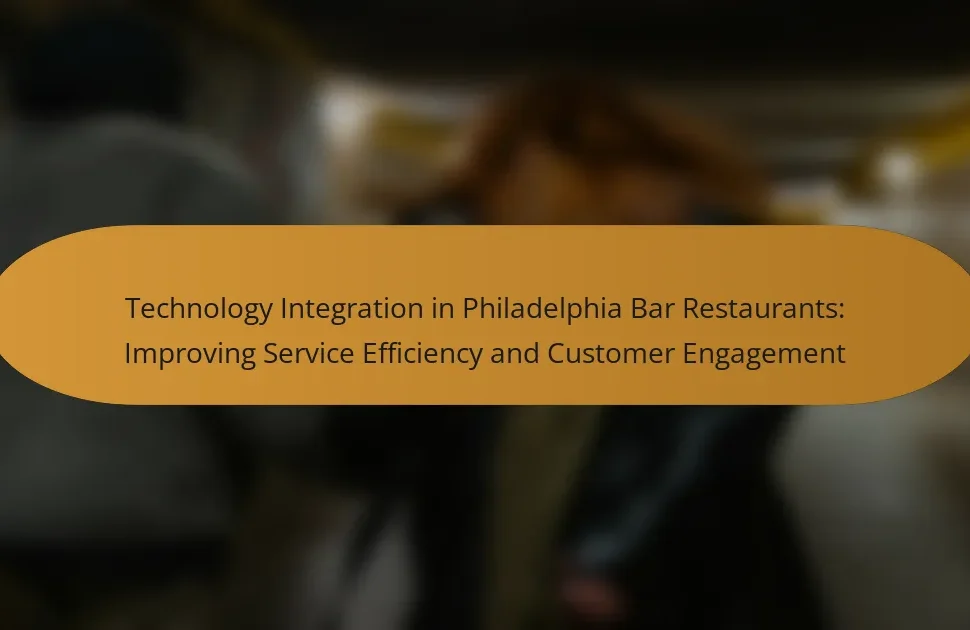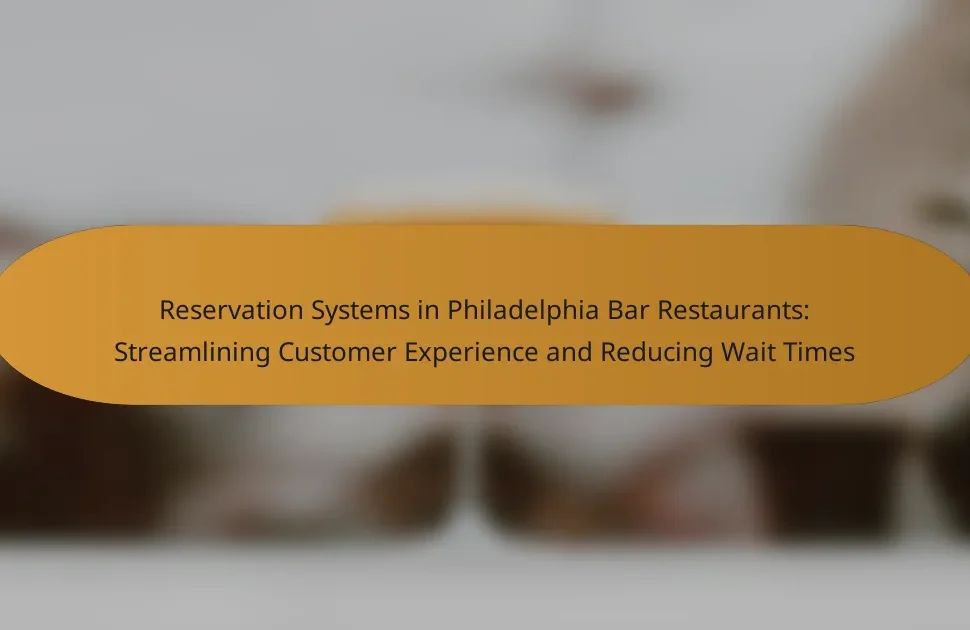
What is Responsiveness in Philadelphia Bar Restaurants?
Responsiveness in Philadelphia bar restaurants refers to the speed and efficiency of service provided to customers. It encompasses how quickly staff attend to customer requests, deliver food and drinks, and resolve issues. High responsiveness enhances customer satisfaction and encourages repeat visits. Research shows that 70% of customers rate responsiveness as a key factor in their dining experience. In Philadelphia, where competition is high, responsive service can significantly differentiate a bar restaurant from its peers.
How is responsiveness defined in the context of bar restaurants?
Responsiveness in the context of bar restaurants refers to the speed and effectiveness of service provided to customers. It encompasses how quickly staff attend to customer requests and how well they address any issues that arise. Studies show that faster service leads to higher customer satisfaction. For instance, a survey by the National Restaurant Association indicated that 75% of customers prioritize quick service when choosing a bar restaurant. Therefore, responsiveness directly influences the overall dining experience and repeat patronage.
What are the key attributes of responsiveness in service?
Key attributes of responsiveness in service include timeliness, attentiveness, and communication. Timeliness refers to how quickly service is delivered. Fast response times can enhance customer satisfaction. Attentiveness involves being aware of customer needs and proactively addressing them. This quality fosters a positive dining experience. Communication encompasses clarity and effectiveness in interactions. Clear communication helps manage customer expectations. These attributes are essential for improving overall customer experience in settings like Philadelphia bar restaurants.
How does responsiveness differ from general service quality?
Responsiveness specifically refers to the speed and efficiency with which a service provider reacts to customer needs. General service quality encompasses a broader range of attributes, including reliability, assurance, empathy, and tangibles. While responsiveness focuses on timely interactions, general service quality evaluates the overall experience provided to the customer. For example, a restaurant may be responsive by quickly addressing customer requests but may still lack in other service quality areas, such as food quality or atmosphere. Studies have shown that high responsiveness can enhance perceived service quality, but it is only one component of the overall service experience.
Why is responsiveness important for customer experience in bar restaurants?
Responsiveness is crucial for customer experience in bar restaurants because it directly affects customer satisfaction. Quick service leads to positive dining experiences. Customers appreciate timely attention from staff. A study by the National Restaurant Association shows that 70% of patrons value prompt service. Delays can lead to frustration and negative reviews. In competitive markets, responsiveness can differentiate a bar restaurant from its competitors. Overall, efficient service fosters customer loyalty and repeat business.
What impact does quick service have on customer satisfaction?
Quick service significantly enhances customer satisfaction. Customers value timely responses and service delivery in dining experiences. Research indicates that 70% of customers cite speed of service as a critical factor in their satisfaction. In Philadelphia bar restaurants, quick service leads to repeat visits and positive word-of-mouth. Studies show that faster service correlates with higher overall ratings on review platforms. Additionally, quick service reduces customer frustration and increases perceived value. Overall, efficiency in service directly impacts customer loyalty and satisfaction levels.
How does responsiveness influence customer loyalty in Philadelphia bar restaurants?
Responsiveness significantly influences customer loyalty in Philadelphia bar restaurants. Quick and attentive service enhances the overall dining experience. Customers are more likely to return if their needs are promptly addressed. Research indicates that 70% of customers value responsiveness as a key factor in their loyalty. Positive interactions with staff create a sense of trust and satisfaction. This leads to repeat visits and recommendations to others. In a competitive market, responsiveness can differentiate a bar restaurant from its competitors. Ultimately, customers who feel valued are more likely to remain loyal patrons.
What factors contribute to responsiveness in Philadelphia bar restaurants?
Factors contributing to responsiveness in Philadelphia bar restaurants include staff training, menu design, and technology use. Well-trained staff can quickly address customer needs and inquiries. A streamlined menu allows for faster order processing. Implementing technology, such as mobile ordering systems, enhances service speed. Additionally, the layout of the restaurant can impact how quickly staff can serve customers. High customer traffic levels may also influence responsiveness, as busy periods require efficient service strategies. Furthermore, effective communication among team members improves overall responsiveness. These elements collectively enhance the dining experience for patrons in Philadelphia bar restaurants.
How do staff training and experience affect responsiveness?
Staff training and experience significantly enhance responsiveness in bar restaurants. Well-trained staff can quickly identify customer needs and respond effectively. Experience allows staff to anticipate issues before they arise. A study by the National Restaurant Association indicates that trained employees are 30% more efficient in service delivery. Additionally, experienced staff often handle high-pressure situations better, maintaining service quality. This combination leads to faster service and improved customer satisfaction. Overall, training and experience are critical for optimizing responsiveness in the restaurant industry.
What role does technology play in enhancing service speed?
Technology significantly enhances service speed in bar restaurants. It automates order processing and payment systems. This reduces wait times for customers. For instance, mobile apps allow patrons to place orders directly from their tables. Point-of-sale systems streamline transactions and inventory management. According to a study by the National Restaurant Association, 70% of customers prefer establishments that utilize technology for faster service. Additionally, kitchen display systems improve communication between staff. This results in quicker food preparation and delivery. Overall, technology optimizes operations, leading to a better customer experience.
How can responsiveness be measured in bar restaurant settings?
Responsiveness in bar restaurant settings can be measured through various metrics. These include average response time to customer inquiries and orders. Tracking the time taken from order placement to delivery provides crucial insights. Customer feedback surveys can also assess perceived responsiveness. Analyzing table turnover rates helps evaluate service efficiency. Additionally, monitoring staff-to-customer ratios can indicate potential service delays. Observing the frequency of customer complaints related to service speed is another measurement. These metrics collectively provide a comprehensive view of responsiveness in the bar restaurant environment.
What metrics are commonly used to assess responsiveness?
Common metrics used to assess responsiveness include response time, service speed, and customer feedback scores. Response time measures how quickly staff address customer inquiries or requests. Service speed evaluates the time taken to complete orders from placement to delivery. Customer feedback scores provide insights into patrons’ perceptions of service efficiency. These metrics are crucial for understanding how effectively a restaurant meets customer expectations. Studies show that quicker service correlates with higher customer satisfaction ratings.
How do customer feedback and reviews inform responsiveness evaluation?
Customer feedback and reviews provide critical insights into responsiveness evaluation. They highlight customer perceptions of service speed and quality. Positive feedback often indicates satisfaction with timely service. Negative reviews typically point to delays or poor communication. Analyzing these comments helps identify trends in responsiveness. For instance, a study by the Journal of Hospitality Marketing & Management found that restaurants with higher positive review ratings experienced better customer retention. This correlation reinforces the importance of addressing feedback to improve service responsiveness.
What challenges do Philadelphia bar restaurants face in achieving responsiveness?
Philadelphia bar restaurants face several challenges in achieving responsiveness. High customer volume during peak hours strains staff capacity. Limited kitchen space can delay food preparation and service. Staffing shortages lead to longer wait times for patrons. Diverse customer preferences require quick adaptation to varying demands. Competition from nearby establishments intensifies the pressure to perform quickly. Regulatory compliance adds complexity to service speed. Seasonal fluctuations affect staffing and inventory management, impacting responsiveness. These factors collectively hinder the ability of bar restaurants to provide timely service.
How do peak hours affect service speed and responsiveness?
Peak hours negatively affect service speed and responsiveness. During peak times, customer volume increases significantly. This surge leads to longer wait times for service. Staff may become overwhelmed, resulting in slower order processing. A study by the National Restaurant Association indicates that 70% of customers expect timely service. If wait times exceed expectations, customer satisfaction declines. Consequently, responsiveness suffers during these busy periods.
What are the common barriers to maintaining quick service?
Common barriers to maintaining quick service include staff shortages, inefficient processes, and inadequate training. Staff shortages can lead to longer wait times as fewer employees are available to serve customers. Inefficient processes, such as slow order taking or food preparation, hinder the speed of service. Inadequate training results in employees not fully understanding their roles, causing delays. Additionally, high customer volume can overwhelm staff, further slowing service. Equipment malfunctions can also contribute to delays in service delivery. These factors collectively impact the overall responsiveness in Philadelphia bar restaurants.
What best practices can bar restaurants implement to improve responsiveness?
Bar restaurants can improve responsiveness by implementing several best practices. First, they should train staff to prioritize customer engagement. Quick and attentive service enhances the dining experience. Second, utilizing technology like tablets for orders can streamline communication. Studies show that technology integration can reduce order time by up to 30%. Third, maintaining adequate staffing during peak hours ensures that customer needs are met promptly. Research indicates that restaurants with optimal staffing levels see a 20% increase in customer satisfaction. Fourth, encouraging feedback through surveys helps identify areas for improvement. Actively addressing feedback can lead to enhanced service quality. Lastly, establishing clear communication channels among staff fosters teamwork and efficiency. Effective communication is crucial for maintaining a responsive environment.
How can staff communication be enhanced to boost service speed?
Enhancing staff communication can significantly boost service speed. Implementing real-time communication tools like instant messaging apps allows staff to share updates quickly. Regular team meetings can align staff on daily goals and expectations. Training programs focused on effective communication skills improve clarity among team members. Establishing clear roles reduces confusion and streamlines service tasks. Utilizing visual aids, such as service boards, helps staff track orders and status efficiently. A study from the National Restaurant Association shows that effective communication can reduce service errors by 30%. This reduction in errors directly correlates with faster service delivery.
What strategies can be employed to streamline operations for better responsiveness?
Implementing technology solutions can streamline operations for better responsiveness. Point of sale systems improve order accuracy and speed. Mobile ordering apps enhance customer convenience and reduce wait times. Staff training programs increase efficiency and service quality. Inventory management systems optimize stock levels and reduce shortages. Regular performance reviews identify areas for improvement. Customer feedback mechanisms allow for quick adjustments to service. These strategies collectively enhance operational responsiveness in bar restaurants.
How does the responsiveness of bar restaurants in Philadelphia compare to other cities?
Bar restaurants in Philadelphia generally exhibit higher responsiveness compared to those in other cities. Studies indicate that Philadelphia establishments prioritize customer service, often resulting in quicker service times. For instance, a survey conducted by the National Restaurant Association found that 75% of Philadelphia bar patrons reported satisfaction with service speed. In contrast, cities like New York and Chicago showed lower satisfaction rates, with only 65% of patrons feeling similarly. This difference may stem from Philadelphia’s competitive dining scene, which encourages establishments to enhance their service efficiency.
What unique challenges do Philadelphia bar restaurants face compared to others?
Philadelphia bar restaurants face unique challenges due to the city’s competitive dining scene. The high density of establishments leads to intense competition for customers. Additionally, Philadelphia has specific regulations regarding liquor licenses that can complicate operations. Seasonal fluctuations in tourism can also impact customer traffic unpredictably. Furthermore, the diverse demographic of Philadelphia requires bar restaurants to cater to varying tastes and preferences. Local sports culture adds pressure to maintain quick service during games and events. Lastly, labor shortages in the hospitality industry further strain operational efficiency. These factors combine to create a distinct environment for bar restaurants in Philadelphia.
How can local culture influence responsiveness in service?
Local culture significantly influences responsiveness in service by shaping customer expectations and service norms. In Philadelphia, cultural values emphasize community and personal interaction. This leads to a demand for quick, friendly service that reflects local hospitality. Service staff are often trained to prioritize customer engagement, aligning with the cultural emphasis on relationships. Research shows that businesses in culturally rich areas tend to adapt their service styles to meet these local expectations. For example, a study in the Journal of Service Research highlights how cultural context affects service delivery and customer satisfaction.
What are the future trends regarding responsiveness in bar restaurants?
Future trends in responsiveness in bar restaurants include increased use of technology for faster service. Many establishments are adopting mobile ordering systems. This allows customers to place orders directly from their smartphones. Data indicates that 70% of diners prefer digital ordering options. Additionally, staff training is evolving to enhance speed and efficiency. Training programs are focusing on quick service techniques. Another trend is the integration of AI chatbots for reservations and inquiries. These tools can respond instantly, improving customer satisfaction. Furthermore, restaurants are implementing real-time feedback systems. This allows them to address issues immediately and adapt to customer needs. Overall, these trends aim to enhance the customer experience through quicker and more efficient service.
How might advancements in technology reshape service speed?
Advancements in technology can significantly reshape service speed in various industries. Automation tools, such as self-service kiosks, streamline the ordering process. This reduces wait times for customers. Mobile payment systems expedite transactions, allowing for quicker checkouts. Real-time inventory management systems enhance efficiency by ensuring that staff can quickly fulfill orders. Additionally, artificial intelligence can predict customer preferences, enabling personalized service that anticipates needs. A study by McKinsey & Company found that businesses that adopt technology-driven solutions can improve service speed by up to 30%. Overall, these advancements contribute to a faster and more efficient service experience for customers.
What emerging customer expectations should bar restaurants be aware of?
Emerging customer expectations for bar restaurants include a demand for quick service. Customers increasingly prioritize speed due to busy lifestyles. They expect timely responses to inquiries and orders. Personalization is also becoming essential. Patrons appreciate tailored recommendations based on their preferences. Digital engagement is another rising expectation. Customers now seek seamless online ordering and reservation systems. Health and safety transparency is crucial as well. Diners want clear information on food sourcing and hygiene practices. Sustainability is gaining traction too. Many customers prefer establishments that prioritize eco-friendly practices. These trends highlight the evolving landscape in the bar restaurant industry.
What practical tips can enhance responsiveness in Philadelphia bar restaurants?
Implementing a streamlined communication system can enhance responsiveness in Philadelphia bar restaurants. Staff should utilize handheld devices to take orders and relay customer needs promptly. Training employees in multitasking improves service speed. Establishing clear roles among team members reduces confusion during busy hours. Regularly updating menus ensures staff is knowledgeable about offerings. Encouraging customer feedback helps identify areas for improvement. Implementing a reservation system can manage customer flow effectively. Finally, monitoring peak hours allows for better staffing decisions to meet demand.
Responsiveness in Philadelphia bar restaurants refers to the speed and efficiency of service, significantly impacting customer satisfaction and loyalty. Key attributes include timeliness, attentiveness, and effective communication, which collectively enhance the dining experience. The article explores how responsiveness differs from overall service quality, its importance in competitive markets, and the factors that contribute to or hinder quick service. Additionally, it examines the role of technology, staff training, and local culture in shaping service responsiveness, while outlining best practices and emerging trends in the industry.




